It's a mad, mad fall
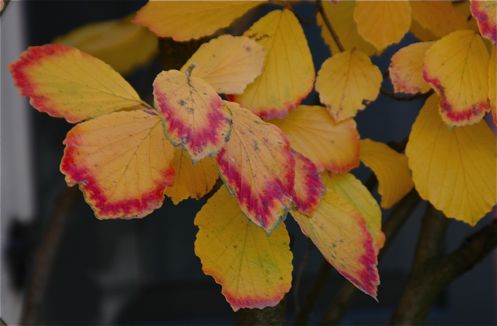
It’s been an odd fall, to say the least. An unseasonably early snowstorm grazed us. The Eurozone is on a daily roller coaster. A Congressional super-committee is holding secret budget talks. Did I mention construction gridlock in the West Village? Sometimes the madness gets to me!
This morning seemed a good time to leave it all behind, if only for an hour, and to admire fall's beautiful colors. Maundering along the brick sidewalks, I mulled one of my own planting design rules: If you have a small garden, or a garden that is easily seen from your windows, pick trees and shrubs that have more than one season’s interest. That way there is always something to look at, and it is SO easy to do.
You could start with witch hazel (Hamemelis x intermedia). While our native witch hazel (Hamamelis virginiana) blooms in fall, the sweet blossoms of the winter blooming species are annual harbingers of the vernal equinox and the coming of spring. The flowers break close to blackish twigs, with narrow, spidery petals in yellow (like the well-known “Arnold’s Promise” or “Pallida”, which are also fragrant), or burnt orange, (try “Diane” or “Jelena”). During summer, its large, crinkly leaves are a bluish green that turn a distinctive yellow and orange in fall, truly delightful. Witch hazels like moist soil, need some shade protection from heat, and are good specimen plants. It is best not prune them into submission unless you are an expert pruner, their vase-like shape is pleasing enough, but I have seen witch hazels espaliered, an interesting alternative in a small garden for a shrub that can grow 10-12 feet tall and wide.
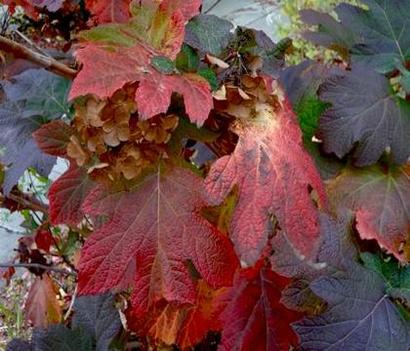
Another fantastic shrub for more than one season’s interest is the native oak leaf hydrangea (Hydrangea quercifolia). Its tan exfoliating bark offers winter interest, and its large, pendulous oak leaf-shaped leaves are a beautiful contrast to the white flowers that appear in mid-summer. Like many hydrangeas, the flowers (actually leaves called bracts), mellow in color over the summer. They fade to a pinkish mauve, before turning a light papery brown just as the leaves turn brilliant shades of scarlet and purple. Oak leaf hydrangeas withstand periods of drought better than some of their cousins, and tolerate shade reasonably well. Like witch hazels, they should be planted where they can grow into their 4-6 foot size with minimal pruning. I have too often seen them badly disfigured by an inexpert pair of secateurs.
By contrast, the drought tolerant smokebush (Cotinus coggyria), which was introduced to North America in 1656, can be heavily pruned, trained to grow as a small tree, or permitted to grow enormous, depending on your preferences. In fact, the small, rounded leaves of the purple form are a deep burgundy color, and are brighter, almost red, on new branches, so some people prune them heavily in spring to stimulate new growth. Remember, though, that spring pruning will sacrifice the flowers because smokebush, like many shrubs, set their flower buds in late summer or fall. Performing most dramatically in full sun, its minute flowers grow in rounded loose

rounded clusters that resemble puffs of smoke. The resultant smokey haze is most dramatic on humid evenings at sunset. I love purple smoke bush planted with blue flowers such as cat mint (Nepeta x faassenii) or Blue Mist Spirea (caryopteris clandonensis), and it is gorgeous with pink spireas and beach roses. In fall, its leaves turn bright orange and deep maroon, a knockout combination that is most vivid on specimens planted in full sun.
The Doublefile Viburnum, (Viburnum plicatum var. tomentosum) is another fantastic shrub that can be heavily pruned, or grown as an espalier, though I love it for its naturally wide shape, about 10 by 10 feet. It grows horizontally, and in late spring bears flat clusters of small white flowers, about 4 inches in diameter, paired all along the length of its branches to stunning effect. No large garden is complete without them, and in Connecticut, where I grew several, the deer generally left them alone, but in the summer, birds came to eat their small dark blue berries. What especially delights me about the stately doublefile viburnum is that it flames into exuberant fall colors of crimson and ruby. One might expect a more restrained fall display from this otherwise dignified shrub.
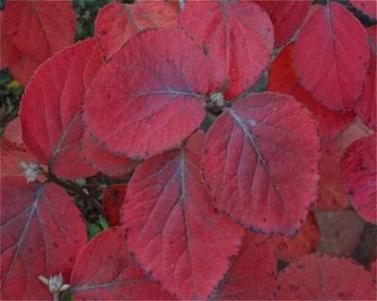
Shadblow (Amelanchier canadensis), a small tree with an open habit and small oval leaves, which turn a gorgeous autumn orange, is definitely refined year-round. This graceful native has four seasons of interest. After the dazzling little orange leaves drop in autumn, bark lovers admire its finely striated gray bark and elegant architecture. Blooming in early spring, its sweet, white flowers, which grow in dainty bunches resembling small nosegays, appear just as the leaves emerge, a bronzy green. In early summer, the amelanchier produces blue edible berries, though you have to beat the birds to them. Amelanchiers typically grow at the edges of woodlands, and are wonderful specimen trees in small gardens. George Washington was a fan and planted them at Mount Vernon.
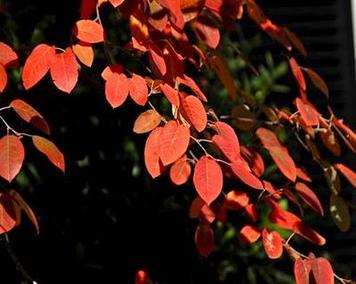
George also loved native dogwoods (Cornus florida), which are almost as gorgeous in autumn as they are in spring. The leaves start to turn just as their bright red berries are being devoured by birds, and vary from deep maroon to cherry red. Like Shadblow, native dogwoods have great bark. It resembles dark brown, craggy alligator skin. In winter, their short twigs are tipped by small, rounded buds that bear the promise of spring. The showy parts of the flowers are bracts, and emerge before the green leaves appear. As if these are not reasons enough to plant them in any garden, large or small, the brilliant fall foliage of the native dogwood, is yet another. Native dogwoods are also understory trees, so they can take some shade, but bloom better in sun, as long as they are not permitted to get dry.
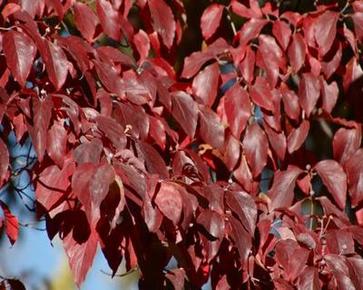
Though fall is indisputably about color, I would be remiss if I didn’t mention a shrub that stays green but will stop you in your tracks should you walk by one. It’s false holly, (Osmanthus), and it is actually a relatively non-descript evergreen until fall when it blooms and its heady perfume fills the air. Twice this fall, as I have been wandering through Georgetown, I have been arrested by its sensual fragrance. It is hard to believe that its flowers, tiny white bells, half hidden by grayish green leaves, could be so powerfully aromatic. It’s a shrub I might place near a doorway where I could breathe in the scent as I was arriving or departing. As it is, there is one in bloom up the block. When the craziness of the world overcomes me – another world leader is toppled or another earthquake hits -- I can just walk along the leafy sidewalk for a quick sniff, and I feel much calmed.

